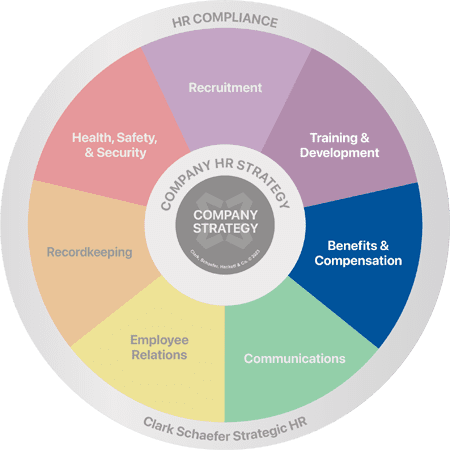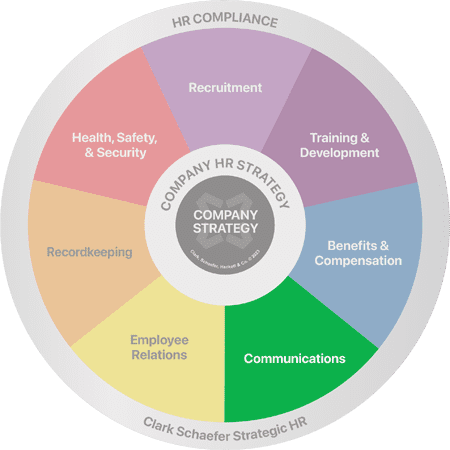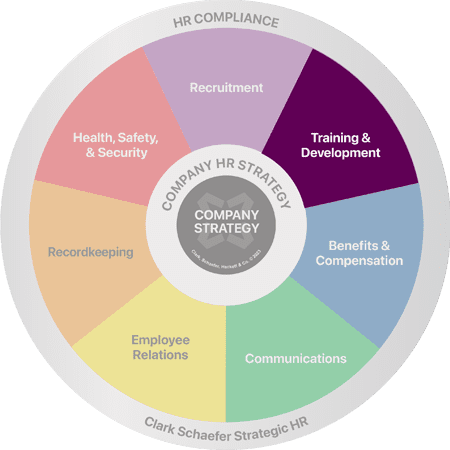Posts
Benefits of Using Employee Engagement Surveys
Last Updatedin Employee Relations
Question:
What is an employee engagement survey and why would our company need one?
Answer:
Employee engagement surveys are a great tool to have to help businesses get their employees involved and actively engaged in operations. Basically, it’s a survey that gives employees the opportunity to share their opinions on the business-related issues of their company to help improve business functionality. Surveys are often administered anonymously and cover topics such as operations, benefits, culture and satisfaction to name a few of the more common ones.
- The first step in conducting an employee survey is be sure the company is committed to taking action based on the input of the employees and to define what that action will be. Action may include telling employees their recommendations cannot be implemented because of certain factors (i.e. cost, time, resources). Responses will need to be sincere and honest and might include ways for employees to overcome any obstacles presented.
- The next step is to plan and construct the survey. There are many online tools and resources to help you create and administer an employee survey. Decide if you will want to have recipients answer questions anonymously. You’ll likely get a larger number of responses and higher quality input by allowing respondents to provide anonymous responses. Using a third party administrator or a highly trusted staff member can be critical to “selling” the anonymity of the survey. If promising secrecy, but sure the survey is conducted with the utmost of confidentiality and explain that in detail to participants.
- Finally determine a plan of action for your line of questioning. What are some trouble-spots in your company that you would like to explore and learn more about? Are you having high turnover? An increase in safety problems? Is productivity down or customer complaints up? Or are you trying to get a read on the pulse of your company and it’s culture? Pick the areas you can tackle and target questions that will help you get the information you need to move forward. Don’t tackle too much in one survey or you will lose employee interest and patience. Your questions can be canned or customized to your situation, long or short, choice-based or open-ended. If this is your first survey, we find even the basic questions can be helpful
- What do you like most about our organization?
- Why do you come to work every day here rather than for another company?
- What would you like to see improved at our organization?
- Would you recommend our organization to a friend as a good place to work? Why or why not?
Once the survey document is complete it’s time to administer the questionnaire. Some great online solutions include SurveyMethods and SurveyMonkey. Both offer various service levels of membership from free to paid access depending on the features you need for your survey. Both allow you to trial these tools to determine what level you need and to see the reporting features provided.
The survey results should help you make improvements and focus on strengths in your organization. You’ll find the feedback from employees will help with developing communications, recruiting techniques, benefits, and more. Employees who operate in the day-to-day of the business tend to have practical suggestions that may not be “huge” or “costly” to implement but can make a big impact. Overall outcomes can include increased safety, productivity, quality, profitability, lower turnover, and higher levels of customer satisfaction. Not to mention that by simply asking employees for their opinions it can heighten their engagement and give them a sense of satisfaction and worth. You’ll see even more value as you repeat the employee survey year after year to assess the improvements.
Has your organization become stagnant? Are you experiencing unusual turnover or employee discontent? Often the simple answer is to simply ASK your employees “what’s going on?” Strategic HR has worked with many organizations, of all sizes and in various industries, to help diagnosis engagement problems and determine the appropriate course of action. Whether it’s an employee survey, focus group, or face-to-face interviews, Strategic HR is your neutral third party solution for finding answers to your questions. Contact us today to find out how we can help you with your particular situation.
Do I Have To Pay Employees for the Company Holiday Party?
Last Updatedin Benefits & Compensation, HR Compliance

HR Question:
Our organization is hosting our annual holiday party, and we’re trying to answer a question – do we have to pay our employees to attend?
HR Answer:
It’s that time of year again – the holiday season is here! And with this season come parties and events designed to celebrate this festive time of year, show appreciation for employees and their contributions, and build team camaraderie by gathering together. Plus, in a labor market where employee retention is a primary concern, holiday parties can be a way to provide levity to a stressful time, show an organization’s thanks and commitment, and engage employees (and potentially, their families). But just because it’s a work-sponsored event, does that mean employers have to compensate their employees for time spent at the party?
Do I Have to Pay Employees for the Holiday Party?
In general, employers are not required to pay employees if the company holiday party is considered voluntary and takes place outside of regular working hours. Holiday parties scheduled during the regular workday should be compensated. If the employer requires all employees to attend an event outside of regular working hours, then it may be considered work time and employees should be compensated for attendance. Be sure to follow applicable FLSA requirements as well as any internal policies that you have established.
How Should I Pay Employees for the Company Holiday Party?
If an employee is exempt, their salary covers all work obligations. Non-exempt employees, however, need to be paid for attending in the following situations:
- If attendance is mandatory, non-exempt employees should be paid for the extra time and travel to and from the party (if it’s not held at the regular work location).
- If the holiday party includes work-related activities, such as a meeting and/or team-building exercises, non-exempt employees should be compensated.
- If a non-exempt employee is working at the event including set-up, clean-up, serving, and/or representing the company (i.e., wearing a mascot costume), they should be paid, even if they are working voluntarily. Want to keep internal costs down and avoid placing additional stress on your team? Don’t ask or permit non-exempt employees to work the holiday party.
It’s important to note some employment contracts or collective bargaining agreements may have provisions that require employers to pay employees for attending certain events, including holiday parties. Be sure to keep those agreements in mind when scheduling or factoring in potential costs for a holiday party.
What Else Should I Consider?
As always, whenever there’s alcohol involved, it’s important to keep some of the legal considerations in mind. For example, do you have a plan for handling alcohol? Will there be drink tickets or a cash bar? Do you plan to enforce a drink limit to help avoid DUIs and other potential risks? These and several others are good questions to ask to determine ways to limit the organization’s liability for this event.
In the end, it’s important for employers to communicate clearly about whether attendance is voluntary, and whether employees will be compensated for their time. The goal of a holiday party is to celebrate, relieve some stress, and enjoy spending time with your team – not to force people to gather if it’s not how they want to spend their time.
Thank you to Becky Foster, Senior HR Business Strategist, and Samantha Kelly for contributing to this HR Question of the Week.
Do you find yourself without answers to tough Benefits and Compensation questions? Whether you need an analysis of your current benefit offerings, a review of your salary structure, or outsourced payroll/benefits administration, Strategic HR Business Advisors can do the job. Please visit our Benefits & Compensation page for more information or Contact Us.
Mandatory Retirement: Is It Legal?
Last Updatedin Employee Relations, HR Compliance
Gauging Employee Engagement
Last Updatedin Communications
Question:
What is an Employee Engagement Survey and why would I need one?
Answer:
An employee engagement survey measures things like how passionate employees are about their work, how proud they are to tell people where they work, if they believe in the mission of the organization, and if they feel their work is valued and their talents are utilized. It has been shown that engaged employees (those that are absorbed by and enthusiastic about their work – they love their jobs) are more productive and creative on the job. Unfortunately, only about 30% of employees are actually engaged – with another 50% disengaged, meaning they are basically just along for the ride.
But an even more startling statistic shares that approximately 20% of employees are “actively disengaged” – these are employees that often dislike their job and/or employer and may even undermine performance. While disengaged employees just get through their day, adding little to the organization and flying under the radar, actively disengaged employees ‘act out’ their disengagement and lack of job satisfaction with destructive results, decreasing productivity for themselves and others around them. They become a cancer in the organization (aka the bad apple ruining the bunch). A Gallup study estimates that actively disengaged employees cost the U.S. economy half a trillion dollars a year.
So whether you’re trying to improve engagement, or eliminate disengagement, it’s important to know where your organization stands, because you can’t solve a problem you don’t know about and ignoring disengagement is costly.
Typically, employee engagement is measured through an employee engagement survey distributed throughout the organization. The content of employee engagement surveys is different from a regular employee survey because engagement measures much more than just happiness or satisfaction. Engagement survey questions generally ask employees to rate their agreement with statements such as:
- I would recommend this company to a friend
- My talents are well utilized
- I believe in the mission of the organization
- My work is recognized and valued
- I have a sense of my career path
Additionally, reporting for employee engagement is sophisticated primarily because managers need to identify engagement issues or successes to pinpoint where they are in the organization. Managers can then drill down into the data, so they can quickly see pockets of high or low engagement. This allows them to discover whether something is pervasive or localized to a specific group and will aid them in fixing problems and creating a stronger and more engaged workforce.
Now that the economy is improving and dissatisfied employees are more apt to change jobs, it may be a good time to measure your employee engagement. An actively disengaged employee can wreak havoc on your high performance employees – negatively impacting their satisfaction and in some cases causing your best employees to leave. Strategic HR has years of experience writing surveys for satisfaction, engagement and performance needs. Visit our Communications page to learn how we can assist you with various communication-based projects.
Employee Engagement…From Beginning to End
Last Updatedin Employee Relations
By Patti Dunham, MA, MBA, SPHR and Debbie Hatke, MA, SPHR
Employee engagement; we’ve heard the term before and as HR professionals we know and we preach that “happy” employees are “productive” employees. But do we really understand engagement? Have we really tried to truly get employees engaged? Do we recognize, and act on the knowledge, that engagement starts well before the employee gets their first paycheck? Are we doing all that we can in every encounter we have with employees to make engagement a reality?
It goes without saying that human capital is the most important asset of every company. We have seen in a number of studies that employee engagement improves the bottom line in almost every instance and it is well worth all organizational efforts to actively engage employees. Helping employees understand the company’s direction and strategic goals, and the significance of their role in meeting those goals is essential. For employees to be committed to an organization and give 150%, they have to feel they have a stake in the company’s success.
Engagement occurs when adequately skilled employees are trained and provided with the appropriate information and tools to make level-appropriate decisions and can lead the organization in the direction of meeting its financial and strategic goals. Sound difficult to take on? It really isn’t. As with all huge projects we must undertake, it is important to break it down into more manageable pieces and success will follow.
Many programs have been created and implemented to introduce the concept of engagement to our employees, but what most of us have failed to do is to start that engagement well before the hire. Integrating employee engagement in the recruitment process is the best way to begin engagement in our organizations and is essential for long term success. Without the “right” hire for the “right” position, many of our other efforts are lost. Getting it right in the beginning is essential. So how do we accomplish this?
Creating and communicating an employment brand to employees.
A well integrated recruitment and selection process will help attract the strongest candidates. Employers who are able to quickly respond to candidates, provide them with feedback and find a way to sort through searchable information for those candidates who are not a match for the current position (but may be a match in a few months) are most successful. The ability to contact candidates quickly, and for them to contact you quickly, will allow you engage top talent and start off on the right foot.
Engaging On-boarding.
In a 2007 Watson Wyatt survey, employers who considered themselves as having a highly engaged workplace took an average of 35 weeks to bring a new hire up to speed. This compares with 15 weeks for companies that considered themselves to have lower levels of engagement. Is your organization spending time on the right activities when bringing employees on board? In addition to the typical on-boarding items, consider addressing the following.
- Explain to the employee WHY they were hired – truly WHY. What is their role and how does it fit in the organization? What do successes and failures look like in the role?
- Share with the new employee what it was about them that made them “the one”. Why did you choose this candidate? Help them understand what you valued in the individual so they can see what skills they have that can be most useful for the company.
- Provide the employee with a realistic job preview. No sugar-coating, please. New recruits must know the job as it is so they can consider their own skills, personality, and abilities to take on tasks necessary for success.
- Express your commitment to learning and development for the employee and the organization. Employees who feel employers are interested in helping them meet their personal goals are more loyal and engaged.
Engaging social networking.
Internal social networks can help your employees feel more connected. Many people use Facebook and Twitter to keep up with friends and colleagues outside of work. An internal network that allows the same type of interaction internally will allow employees to share knowledge, experiences, and interests online – a much more appealing way for some generations to interact, yet still allows employees to be involved and a part of the organization.
Employee engagement is essential and impacts your employees from well before employment all the way to resignation and/or retirement. There is a strong correlation between effective recruitment, on-boarding/integration, and the financial performance and success of a company. When addressed thoroughly, essential talent will be drawn to your company and quickly engaged. And once you reap the rewards you will easily see that engaged employees are well worth the effort.
Patti Dunham, MA, MBA, SPHR and Debbie Hatke, MA, SPHR are Senior Human Resources Management Consultants with Strategic Human Resources, Inc. (www.strategicHRinc.com). If you have questions or comments about this article, you can contact Debbie at Debbie@strategicHRinc.com and Patti at Patti@strategicHRinc.com.
Contact Us
Clark Schaefer Strategic HR
10856 Reed Hartman Hwy
Suite 225
Cincinnati, OH 45242

Clark Schaefer Strategic HR is recognized by SHRM to offer Professional Development Credits (PDCs) for SHRM-CP® or SHRM-SCP® recertification activities.
The information provided on this website does not, and is not intended to, constitute legal advice; instead, all information, content, and materials available on this site are for general informational purposes only. Readers of this website should contact their attorney to obtain advice about their particular situation and relevant jurisdiction. This website contains links to other third-party websites. These links are only for the convenience of the reader, user or browser; Strategic HR does not recommend or endorse the contents of the third-party sites.




